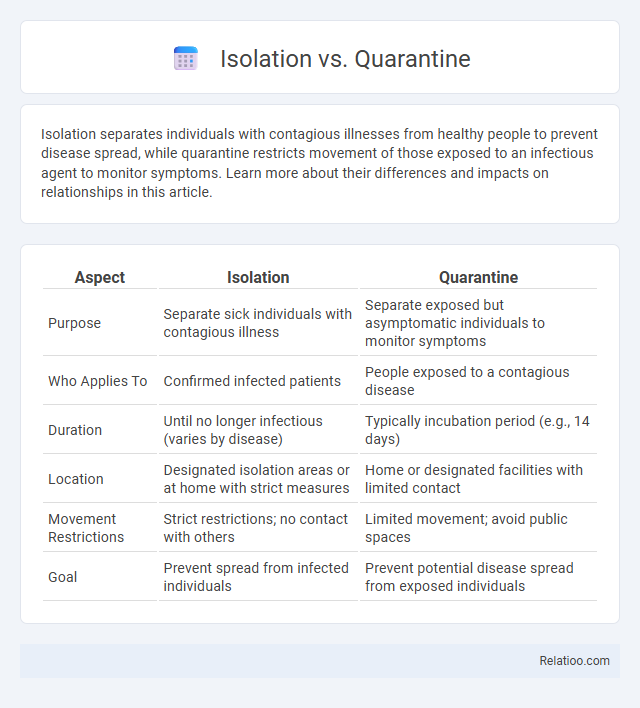Isolation separates individuals with contagious illnesses from healthy people to prevent disease spread, while quarantine restricts movement of those exposed to an infectious agent to monitor symptoms. Learn more about their differences and impacts on relationships in this article.
Table of Comparison
| Aspect | Isolation | Quarantine |
|---|---|---|
| Purpose | Separate sick individuals with contagious illness | Separate exposed but asymptomatic individuals to monitor symptoms |
| Who Applies To | Confirmed infected patients | People exposed to a contagious disease |
| Duration | Until no longer infectious (varies by disease) | Typically incubation period (e.g., 14 days) |
| Location | Designated isolation areas or at home with strict measures | Home or designated facilities with limited contact |
| Movement Restrictions | Strict restrictions; no contact with others | Limited movement; avoid public spaces |
| Goal | Prevent spread from infected individuals | Prevent potential disease spread from exposed individuals |
Understanding Isolation and Quarantine: Key Definitions
Isolation separates individuals diagnosed with contagious diseases to prevent spread, while quarantine restricts movement of those exposed but not yet symptomatic. Both strategies are crucial in controlling infectious outbreaks like COVID-19 by reducing transmission risks. Understanding the distinct purposes ensures effective public health responses and minimizes community impact.
Purpose and Goals of Isolation vs Quarantine
Isolation separates individuals confirmed to be infected with a contagious disease to prevent spreading it to others, focusing on containing the infection during the contagious period. Quarantine restricts the movement of individuals exposed to a contagious disease but not yet symptomatic, aiming to monitor symptoms and prevent potential transmission. Your understanding of the distinct purposes and goals of isolation and quarantine helps ensure effective public health responses and personal safety measures.
Medical Criteria for Isolation and Quarantine
Isolation is medically mandated for individuals diagnosed with contagious diseases to prevent transmission by separating them from healthy populations, typically in healthcare settings until they are no longer infectious based on clinical and laboratory criteria. Quarantine involves restricting movement of asymptomatic individuals exposed to a contagious disease during the incubation period to monitor symptoms and reduce spread, guided by exposure risk assessment and local epidemiological data. Both isolation and quarantine rely on specific medical criteria such as symptom resolution, negative test results, and exposure timelines to determine duration and ensure public health safety.
Duration: How Long Should Isolation and Quarantine Last?
Isolation typically lasts at least 5 to 10 days from symptom onset or positive test, depending on severity and guidance from health authorities like the CDC. Quarantine duration usually spans 7 to 14 days following exposure to a contagious disease, aiming to monitor symptoms and prevent spread. Extended isolation or quarantine periods may be required for immunocompromised individuals or those with severe infection cases.
Common Scenarios for Implementation
Isolation is commonly implemented for individuals confirmed to have contagious diseases, such as COVID-19 or tuberculosis, to prevent spreading to others. Quarantine applies to those exposed to infectious agents but not yet symptomatic, like travelers returning from outbreak zones requiring monitoring. Cohorting involves grouping patients with the same infection in healthcare settings to optimize resource use while minimizing transmission risks.
Legal and Ethical Considerations
Isolation, quarantine, and segregation differ legally and ethically in their application and enforcement, focusing on public health protection while respecting individual rights. Legal frameworks mandate isolation for confirmed cases of contagious diseases, ensuring containment, whereas quarantine applies to individuals potentially exposed but asymptomatic, balancing disease prevention with liberty restrictions. Ethical considerations emphasize informed consent, proportionality of measures, and access to resources, preventing discrimination and safeguarding dignity during these public health interventions.
Psychological Impacts of Isolation and Quarantine
Isolation and quarantine, crucial for controlling infectious diseases, both impact mental health by increasing feelings of loneliness, anxiety, and depression. Your psychological well-being may suffer during isolation due to the absence of social interaction and the stress of being confined, while quarantine can trigger fear and uncertainty about health outcomes. Implementing coping strategies, such as virtual communication and mental health support, is essential to mitigate these adverse effects during both isolation and quarantine periods.
Practical Tips for Coping and Compliance
Isolation separates individuals confirmed to be infected, while quarantine restricts those exposed to the virus but not yet symptomatic, and both require clear communication of duration and symptoms monitoring. Your best approach includes creating a comfortable, well-ventilated personal space, maintaining hydration and nutrition, and using digital tools for medical updates and mental health support. Adhering to guidelines such as mask-wearing, hand hygiene, and limiting contact with others in the household enhances your compliance and speeds recovery.
Public Health Outcomes and Effectiveness
Isolation separates individuals confirmed to be infected from healthy populations, significantly reducing disease transmission by containing contagious pathogens within controlled settings. Quarantine restricts movement of potentially exposed but asymptomatic individuals, enabling early detection and preventing presymptomatic spread, which is critical in managing outbreaks of infectious diseases like COVID-19. Combining isolation and quarantine with targeted public health interventions enhances effectiveness by minimizing community spread and optimizing resource allocation for healthcare systems.
Frequently Asked Questions about Isolation and Quarantine
Isolation separates individuals diagnosed with contagious diseases from those who are healthy to prevent spread, while quarantine restricts the movement of people who may have been exposed but are not yet symptomatic. Common FAQs include the duration of isolation, which often depends on symptom resolution and negative test results, and the distinction between quarantine length based on exposure risk levels. Understanding these differences helps implement effective public health measures and reduces transmission risks in communities.

Infographic: Isolation vs Quarantine
 relatioo.com
relatioo.com